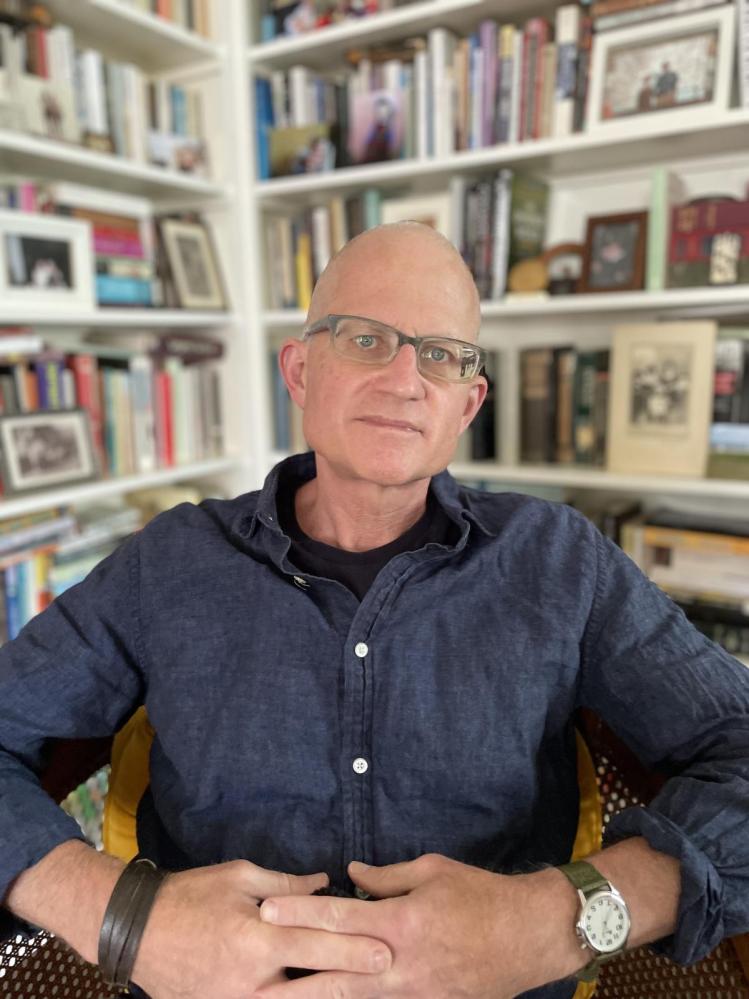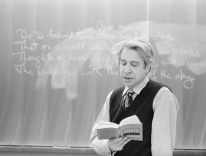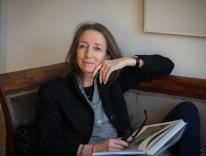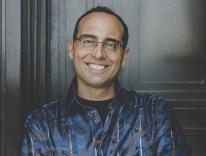
Zero at the Bone is hard to categorize. It’s part autobiographical sketches, part philosophical and theological reflections, and, of course, part poetry. Most of the writing in these fifty “entries against despair,” poetry and prose alike, is contemporary, and much of the poetry is by Wiman himself. Everything, whatever its genre or origin, circles around questions of faith, though it’s a faith that can be possessed only by both the suspension of disbelief and the suspension of belief itself. Both skepticism and religious wordiness seem to be enemies of faith, perhaps even allies of despair. Wiman calls us instead to an appreciation of the beautiful because, he writes, “beauty triggers an instinct for an order beyond the one it enacts.” Atheism and theism are too often empty intellectual exercises, and theology is almost always so, but poetry simply is not.
Of course, the suspicion that the intellect is not the way to God has a long pedigree, most notably in the fourteenth-century English mystical text The Cloud of Unknowing, which warns us that “by our love, the divine may be reached and held; by our thinking, never.” But here Wiman seems to press poetry into the service of faith, into hearing the Word in the everyday. Reflecting on the remarkable poem “Prayer” by Carol Ann Duffy, he suggests that “the Word might come from the leaves of a tree, or a rudimentary piano lesson, or a radio’s shipping forecast.” Faith comes first from hearing, “literally, from the air, from sound,” which is the way that poetry works upon the hearer, and why, Wiman rightly says, poetry must be read aloud. Treat it like prose and you are searching for the meaning. But its meaning can only enter you through the sounds, just as the Word of God reaches a person through everyday occurrences.
Because this is a book into which the reader can dip almost anywhere, it doesn’t make sense to seek the thread of an argument. An argument would be way too heady, but Wiman admits that he, too, (like “the common reader”) is attracted to “poems that reach for succinct and universalizing statements.” The problem with such statements is “that life is often inimical to them.” We may want the comfort of universal truths, but “there is a severe contradiction between our need to speak of ultimate things and the immunity of those things from speech.” Enter poetry again, which is a good place for “the speech that gives presence to that which will not be spoken.” This clearly verges on the religious: poetry “can enact and enable the proper fear one feels when approaching any absolute (including, if need be, the absolute truth of contingency), and it can enact and enable it (the fear’s) falling away.”
Here, then, is a kind of faith that is intense but “both provisional and perishable.” This poetic faith is “a matter of nerve and instinct,” in contrast to religious faith, which may “emerge” from the nerves but “requires a conscious leap.” Poetic faith embraces the realities and pains of this world, whereas religious faith looks for “one world more than our wounds have earned”—one too many, Wiman seems to suggest.
Wiman’s “faith,” sometimes poetic and at other times religious, is a slippery thing. There is nothing original in suggesting that doubt sometimes challenges the person of faith, but Wiman wants something else—not faith one day and doubt the next, but faith and doubt, simultaneously. Doubt is integral to Wiman’s faith—but wait! “You can make an idolatry of doubt,” he warns, becoming so comfortable or complacent “with God’s absence and distance that eventually your own unknowingness gives you a big fat apophatic hug.” If doubt is where you are going, then maybe you should resist it. Why can’t we just let the world be the world, he asks; why must we talk of Incarnation and Resurrection? And then he responds to his own question: there is more to the world than what is visible to us. “We know in our bones that this is so, and sacred,” Wiman writes, but “we know in our bones that we can never know that this is so, and that lack is also sacred.” His discussion of the work of William Bronk is particularly poignant here, playing with the nuances of apophasis and agnosticism: “Not this, not this, not this, he says over and over, until, in the interstitial silence, some volatile possibility of this-ness begins to glow.” The religious mystic’s dark night of the soul hangs on the same fruitful contradiction.
And, Wiman asks, how can we believe that whatever we pray for we will receive, when it is obviously not always the case? He answers this question with a blend of Zen Buddhism and quantum theory. Might it not be the case that it is “both more literal and less literal than it seems”? “Scripture is no more static than electrons are,” and “its meaning depends on your position in space and time.” The “all things” that you ask in prayer today are asked not of “God” but of “things”—that is, your prayer life is hopeful but realistic. You’re not hoping for magic. You have to let be what will be, he seems to be suggesting, and to be both attentive and patient. Wiman might have supported and clarified this thought about prayer with Jesus’ words in the garden of Gethsemane: a hope, concluded with resignation to the will of God.
If Wiman is not a theologian but a poet, and not especially taken up with any particular branch of Christianity, it is quite remarkable how much depth of insight he has into the way the grace of God works in the world. Time after time, his own poetry and the poems he quotes are suffused with the kind of sacramental imagination of which Gerard Manley Hopkins was such an exponent. “Pied Beauty” and the entirety of “The Windhover” demonstrate Wiman’s vision exactly, and Wiman’s book echoes Hopkins’s own view of poetry. In an 1864 letter to his friend Alexander Baillie, Hopkins wrote that “the first and highest” kind of poetry is “poetry proper, the language of inspiration” that “can only be written…by poets themselves. Everybody of course has like moods, but not being poets what they then produce is not poetry.” He suspected Tennyson and Wordsworth of not reaching that high bar. Wiman, like Hopkins before him, understands how “God” serves the imagination’s need for faith that we are all called to, believers or not.
In the end, the deepest religious drive in Zero at the Bone is the challenge of suffering. Wiman’s own life has been full of what Simone Weil called “affliction.” Her ghost is present throughout these pages; her understanding of “attention” as a kind of waiting upon truth to appear is not unlike the disposition Wiman thinks one must have when receiving a poem. Wiman quotes Weil here and there, most substantially toward the end of the book in his lengthy autobiographical section 45, “The Cancer Chair.” For Weil, God seeks out the soul and conquers the one who at least for a moment shows “a pure and utter consent” to God. But “when it has become entirely his he abandons it.” Left alone, the soul goes in search of him whom it loves, she says, and this recapitulates the search God had made for it, though starting from the opposite end, which is the cross. Weil’s own struggles with religion and suffering are evident; what Wiman makes clear in this book is that this is the way things are meant to be. Like Richard Rohr, he insists that the goal of life is not to become spiritual, but to become human, with all its meanings. It is to be a disciple of the kenotic God, the one who is emptied of divinity, the human Christ. And Wiman is perhaps closer still to the words of the Zen teacher Eido-roshi quoted at the end of Pico Iyer’s wonderful book The Half Known Life: “The struggle of your life is your paradise.”
Zero at the Bone
Fifty Entries Against Despair
Christian Wiman
Farrar, Straus and Giroux
$30 | 320 pp.
Please email comments to [email protected] and join the conversation on our Facebook page.
Previous Story
Solidarity and Sacrifice
Next Story
Can We All Agree to Dignity?


